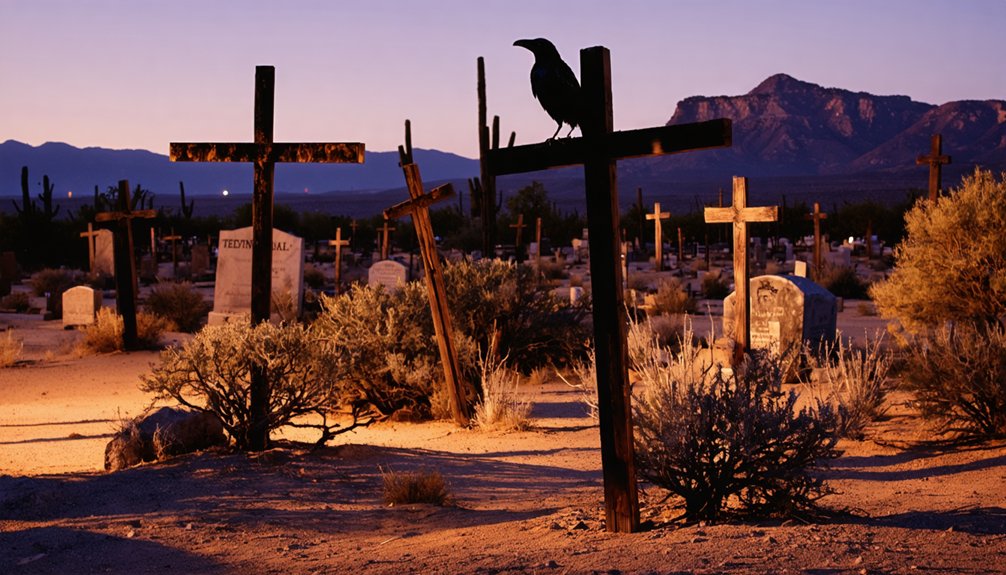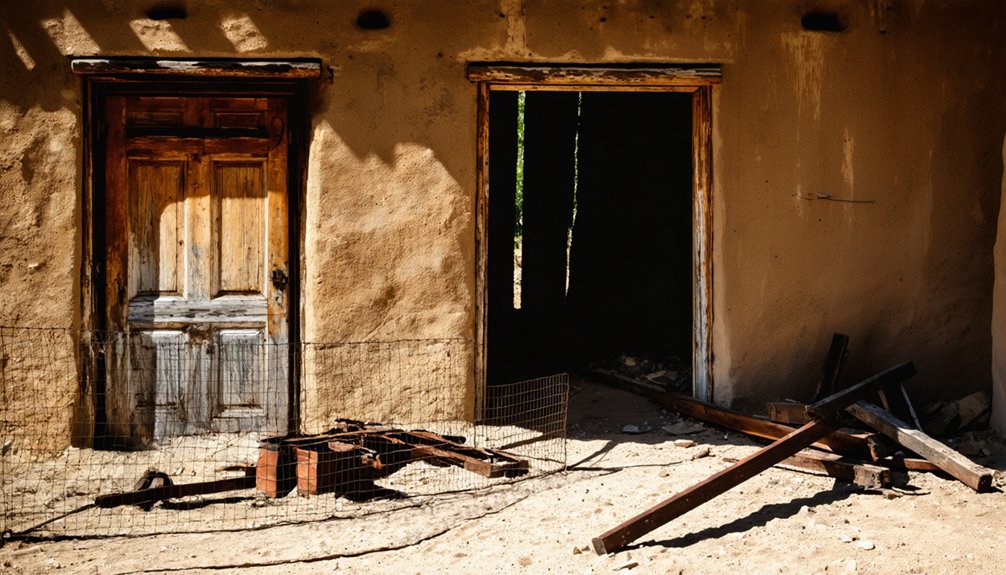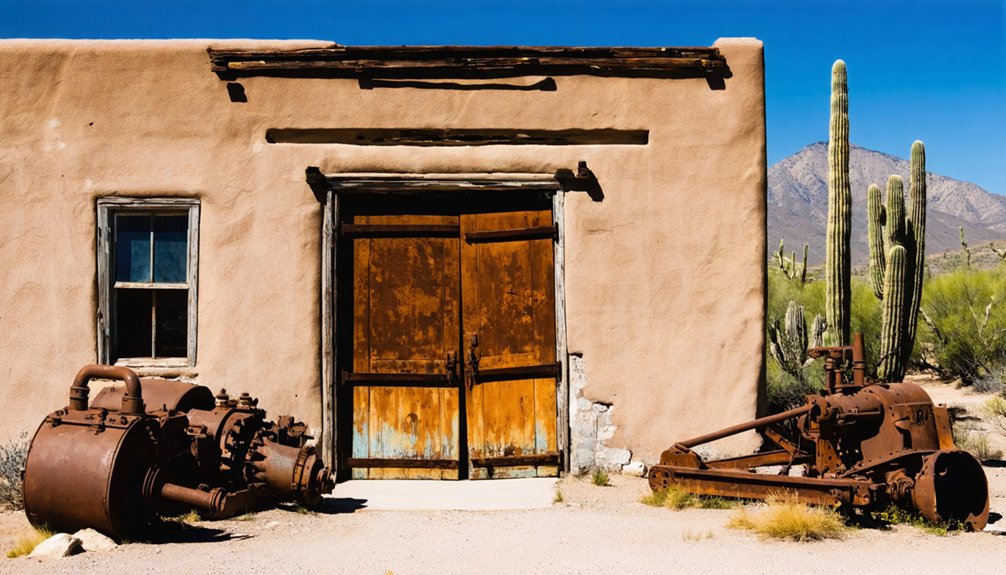You’ll find Helvetia nestled in Arizona’s Santa Rita Mountains, a copper mining town established in 1891 by Swiss immigrant Ben Hefti. At its peak during 1895-1903, this cultural melting pot housed 650 residents before declining as copper prices crashed. Today, you can explore scattered adobe foundations, the weathered smelter ruins, and a pioneer cemetery with bullet-marked wooden crosses. The site gained fame as the filming location for Paul Newman’s 1967 western “Hombre.”
Key Takeaways
- Helvetia was established in 1891 by Swiss miner Ben Hefti and became Pima County’s most significant mining operation.
- The town reached its peak population of 650 during the 1895-1903 copper boom before declining after 1907.
- Now abandoned, Helvetia exists only as scattered ruins, foundation walls, and a pioneer cemetery across Arizona’s desert landscape.
- The diverse community featured Hispanic, Swiss, and American influences centered around a 150-ton smelter and ore extraction.
- Helvetia gained fame as the filming location for the 1967 Western “Hombre” starring Paul Newman.
The Swiss-Named Mining Settlement in the Santa Rita Mountains
Nestled in the copper-rich folds of southern Arizona’s Santa Rita Mountains, Helvetia emerged in 1891 as a tribute to immigrant ambition and mineral wealth.
You’ll find its name reflects the vision of Ben Hefti, a Swiss miner who christened the settlement after his homeland’s Latin poetic designation—a name symbolizing liberty and fresh beginnings for the area’s newcomers.
The settlement’s Helvetia history began as Paine Webber & Company conducted early ore testing, strategically positioning their operations where copper deposits promised prosperity.
Within this mining legacy, Helvetia quickly established connections to nearby Rosemont Camp, just four miles southeast. Like its ancient namesake that was once depicted as a bull in the 1580s, the town embodied strength and resilience in the harsh desert landscape.
The location wasn’t chosen by chance—the Santa Ritas’ geological bounty made it ideal for what would soon become Pima County’s most significant mining operation, transforming a simple camp into a thriving community.
During its heyday, the town boasted standard amenities including a store, saloon, school, and stage line that served the needs of approximately 300 residents at its peak population.
Copper Dreams and Economic Reality (1891-1921)
You’d find Helvetia at its peak between 1895-1903, when it emerged as Pima County’s largest mining camp with a 150-ton smelter, company buildings, and a population that swelled from 55 to 350 workers.
The copper boom couldn’t last, as plummeting prices after 1907 forced the smelter’s closure and operations to struggle until 1911 under the management of the Helvetia Copper Co. of Arizona.
Boom Town Prosperity
As copper prices soared in the early 1890s, Helvetia transformed from a modest collection of mining claims into Pima County’s most significant mining settlement, embodying the boom-and-bust cycle typical of western resource towns.
By 1898, you’d have found yourself amid a bustling copper boom town with 350 workers and a population reaching 650. The Helvetia Copper Company’s $800,000 investment yielded impressive returns, processing ore with 8-10% copper content.
The mining legacy expanded with infrastructure development including a narrow-gauge railroad and aerial tramway spanning 5-6 miles.
Town life thrived with four saloons, a Chinese laundry, barbershop, and meat market. Two stagecoach lines connected you to Tucson, while wagon roads linked to Vail’s train station, integrating this remote outpost with Arizona’s growing transportation network.
Copper Market Collapse
While Helvetia enjoyed brief prosperity during the copper boom, the town’s fortunes began reversing dramatically after 1907 when copper prices plummeted from their historic highs.
You’d recognize these copper price fluctuations as part of the broader economic upheaval that would culminate in the Great Depression years later. The mining industry struggles in Helvetia mirrored those across Arizona, where operations faced mounting costs and diminishing returns.
Like many copper towns, Helvetia lacked the economic diversity to weather such downturns. The Sherman Silver Purchase Act of 1890 had already devastated silver mining economies, and copper towns soon faced similar economic collapses.
When mining operations suspended in the early 1910s, you’d have witnessed families packing their belongings, abandoning homes they’d built just years before.
The railroad that once transported copper ore now carried away Helvetia’s residents, leaving behind silent mills and empty buildings as evidence of copper’s boom-and-bust reality. Arizona’s overall copper production reached 750,000 metric tons in 2007, showing the eventual recovery of the industry that once abandoned towns like Helvetia.
Life in a Frontier Border Town: People and Culture
At the foothills of the Santa Rita Mountains, you’d find Helvetia’s 300 residents forming a distinctive cultural melting pot, with Hispanic workers comprising the majority population due to the town’s proximity to the Mexican border.
Your visit to this Swiss-named settlement would reveal miners dwelling in simple adobe homes, gathering at the local saloon after grueling shifts in the copper mines that defined their existence.
Despite harsh working conditions, you’d observe a community bound together by necessity and survival, where miners from different backgrounds established rhythms of daily life centered around the 150-ton smelter and the economic pulse of ore extraction. The surrounding landscape was marked by mine shafts and slag heaps, physical reminders of the industry that brought the town into existence. Like other Arizona ghost towns that experienced population decline, Helvetia’s community dispersed after the mines closed, leaving behind only remnants of its once-vibrant frontier culture.
Cultural Melting Pot
Unlike many mining towns that developed homogeneous populations, Helvetia thrived as a genuine cultural melting pot where Mexican, Swiss, and American influences converged in the rugged Arizona borderlands.
Walking through Helvetia at its peak, you’d have encountered a community where cultural diversity shaped daily life. The mainly Hispanic workforce—Mexican nationals and Mexican-Americans—formed the backbone of mining operations, while Swiss influences permeated the town’s very identity through its Latin-derived name, chosen by immigrant Ben Hefti.
This cultural tapestry created a distinctive community identity where European naming traditions existed alongside Spanish language and Mexican customs. With approximately 300 residents, the town maintained a vibrant community despite its relatively small size.
In the town’s saloons and general store, conversations flowed in multiple languages as residents navigated the complexities of frontier life, creating a borderland society that reflected Arizona’s position between nations and cultures. The town flourished briefly until declining copper prices forced mine closures in 1911, effectively ending Helvetia’s cultural experiment.
Miners’ Daily Existence
Deep beneath Arizona’s rugged landscape, Helvetia’s miners faced grueling daily challenges that defined their existence in this frontier copper town.
With up to 350 men employed during peak years, your ancestors endured miners’ routines marked by dangerous underground work, followed by evenings in one of four saloons where paychecks quickly diminished.
- Laborers lived in a “motley collection of tents and adobe shanties,” showcasing the transient nature of mining life.
- Daily hardships included water scarcity that affected both smelting operations and personal hygiene.
- Economic volatility meant constant employment uncertainty as copper prices fluctuated wildly.
- After exhausting shifts, miners found community among diverse neighbors—patronizing Chinese laundries, cobbler shops, and the local barbershop.
The predominantly Mexican population worked the copper mines that brought Helvetia into existence in 1891, creating a unique cultural atmosphere in this remote mountain settlement.
What Remains Today: Tracing Helvetia’s Footprint
The ghost town of Helvetia now exists as little more than scattered fragments across the Arizona desert landscape, with only a handful of foundation walls and the weathered smelter ruins standing as silent sentinels to its mining heyday.
Faded walls and crumbling smelters whisper forgotten stories across Helvetia’s sun-bleached Arizona remains.
These ghostly remnants tell a tale of boom-and-bust amid slag heaps and abandoned mine shafts that define the area’s mining heritage.
You’ll find the cemetery most accessible and hauntingly intact, with wooden crosses marked by barbed wire or bullet holes rather than names.
The cemetery’s wooden crosses, hastily constructed and held together with barbed wire fencing, create a sobering memorial to those who once called this place home.
While the Ray Mine remains the primary accessible site, most of Helvetia is fenced off.
No complete buildings survive, as desert reclamation has steadily erased human presence.
The nearby Rosemont copper project hints at potential future mining, even as coyotes roam freely through what was once a bustling frontier community.
The Haunting Cemetery: Wooden Crosses and Local Legends

Weathered by decades of harsh desert conditions, Helvetia’s pioneer cemetery stands as perhaps the most haunting remnant of the once-thriving mining town.
You’ll find hastily constructed wooden crosses, some riddled with bullet holes and bound with aging barbed wire, marking final resting places without names or dates. Local volunteers like the LaValley family have attempted grave preservation, though state authorities later removed the carefully placed rock outlines that identified burial sites.
- Visitors report eerie sounds and unexplainable atmospheric changes around dusk
- Photographs taken at night reveal strange anomalies and ghostly apparitions
- Howling coyotes intensify the desolate ambiance that fuels local ghost stories
- The cemetery’s random layout reflects frontier burial customs without municipal oversight
The cemetery remains largely unmaintained except for volunteer efforts, slowly decaying as a somber memorial to Helvetia’s forgotten pioneers.
Hollywood in the Desert: Helvetia as a Film Location
Beyond its crumbling mining structures and haunting cemetery, Helvetia achieved brief Hollywood fame when director Martin Ritt chose the ghost town as the primary filming location for “Hombre” in 1967.
Paul Newman starred in this Elmore Leonard adaptation, with Helvetia’s well-preserved mining camp providing the authentic western backdrop the production demanded.
You’ll appreciate the cinematic authenticity that drew filmmakers to this remote site—the genuine frontier architecture required minimal alteration, allowing the desert landscape to speak for itself.
Helvetia’s film legacy lives on as tourists seek out recognizable locations from the movie, walking the same paths Newman once trod.
Film buffs still wander Helvetia’s dusty streets, retracing Newman’s footsteps through this authentic slice of cinematic history.
Despite challenging conditions and limited infrastructure, film crews praised the location’s isolation and period accuracy, cementing Helvetia’s place in western film history.
Environmental Challenges and Preservation Efforts

While Helvetia’s crumbling structures captivate visitors with their haunting beauty, they mask a complex environmental legacy that continues to impact the surrounding landscape.
You’ll find abandoned mines, slag heaps, and toxic waste creating ongoing preservation challenges for this historical site. Water scarcity—historically problematic for smelter operations—remains a critical concern as mining-related contamination threatens local springs and wildlife.
- Acidic mine drainage creates long-term environmental impact on surface waters
- Minimal legal requirements for site restoration under Arizona’s Mining Reclamation Act
- Nearby Rosemont mine proposal raises concerns about aquifer depletion
- Tension between the 1872 Mining Law’s minimal safeguards and modern conservation needs
Unlike better-preserved ghost towns like Swansea, Helvetia lacks formal preservation infrastructure, leaving its future uncertain amidst competing interests of historical preservation and environmental remediation.
Frequently Asked Questions
Is Helvetia Accessible by Public Transportation?
No, you can’t access Helvetia by public transit. Your accessibility options are limited to private vehicles since all public transportation infrastructure ceased operations in the 1920s after town abandonment.
Were Any Famous People Born in or Associated With Helvetia?
You won’t find famous residents in Helvetia’s history. Besides Ben Hefti, who named the town for his Swiss heritage, no notable historical figures emerged from this small mining community.
What Caused the Fires That Damaged Parts of Helvetia?
Like moths to flame, you’ll find the primary fire origins at the copper smelter, where molten slag ignited wooden floors in 1900. Poor fire suppression and wooden construction had devastating historical implications for Helvetia’s survival.
Did Any Significant Crimes or Outlaws Shape Helvetia’s History?
You won’t find outlaw legends in Helvetia’s documented crime history. Historical records focus on mining operations and economic decline rather than criminal activity that might’ve shaped the town’s development.
Are There Guided Tours or Annual Events at Helvetia?
Currently, Helvetia doesn’t offer formal guided explorations or historical reenactments. You’ll need to explore this remote ghost town independently, embracing the freedom to discover its scattered ruins at your own pace.
References
- https://www.nrafamily.org/content/creepy-october-the-ghost-of-helvetia-cemetery/
- https://www.mindat.org/loc-49290.html
- https://winfirst.wixsite.com/arizonamininghistory/helvetia
- https://www.minershop.com/blogs/minershop-blog/helvetia-trip-report
- http://www.apcrp.org/HELVETIA/Helvetia_Mast_121308.htm
- https://www.ghosttowns.com/states/az/helvetia.html
- https://data.azgs.arizona.edu/api/v1/collections/AGCR-1552427939083-312/cr-14-d_helvetia-rosemont.pdf
- https://www.gvrhc.org/Library/Helvetia.pdf
- https://en.wikipedia.org/wiki/Helvetia
- https://pubs.usgs.gov/bul/1027f/report.pdf



